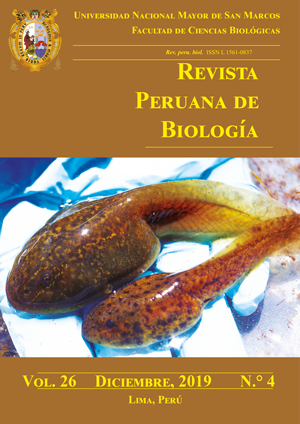Variation of the abundance of Lama guanicoe in Bosque Fray Jorge National Park Coquimbo, Chile, and its relation with plant cover
DOI:
https://doi.org/10.15381/rpb.v26i4.15990Keywords:
Andean camelids, Animal reintroduction, Fauna traslocation, Large herbivore, Population restorationAbstract
Lama guanicoe was distributed in the Andes of Chile from Arica and Parinacota to Magallanes. Currently its distribution is fragmented with populations in Tarapaca, Coquimbo, Aysen and Magallanes Regions. In the Bosque Fray Jorge National Park (Coquimbo), the last populations of wild guanacos were observed in the year 1920. In 1994, eight individuals were released in the Park, of which five survived. Since then, occasional counts of the reintroduced population were made. In November 2013, a monitoring methodology was developed based on count transects. The objectives were to analyze the historical changes in the population of guanacos in the Park and determine the use and selection of habitats. Linear models were used to analyze population trends and the Manly Selection Ratio for habitat selection. There was an increase in the population to 33 individuals. The main use that they gave to the types of cover was the feeding and they selected the Mediterranean Mediterranean Desert Scrub of Heliotropium stenophyllum and Fluorensia thurifera. It is recommended to mark the guanacos with satellite collars to monitor the movements of the troops, establish territories and measure the population size.
Downloads
Downloads
Published
Issue
Section
License
Copyright (c) 2019 Víctor Cook-Mena, César Lautaro Chávez-Villavicencio, Paula Martínez-Palma, Elier Tabilo-Valdivieso

This work is licensed under a Creative Commons Attribution-NonCommercial-ShareAlike 4.0 International License.
AUTHORS RETAIN THEIR RIGHTS:
a. Authors retain their trade mark rights and patent, and also on any process or procedure described in the article.
b. Authors retain their right to share, copy, distribute, perform and publicly communicate their article (eg, to place their article in an institutional repository or publish it in a book), with an acknowledgment of its initial publication in the Revista Peruana de Biologia.
c. Authors retain theirs right to make a subsequent publication of their work, to use the article or any part thereof (eg a compilation of his papers, lecture notes, thesis, or a book), always indicating its initial publication in the Revista Peruana de Biologia (the originator of the work, journal, volume, number and date).






